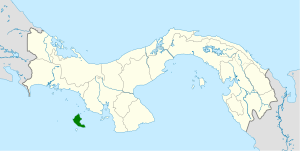Coiba spinetail facts for kids
Quick facts for kids Coiba spinetail |
|
|---|---|
| Conservation status | |
| Scientific classification | |
| Genus: |
Cranioleuca
|
| Species: |
dissita
|
 |
|
| Synonyms | |
|
Craniolecua vulpina dissita |
|
The Coiba spinetail (Cranioleuca dissita) is a special type of bird called an ovenbird. It belongs to the family Furnariidae. This bird lives only on Coiba and Ranchería Islands in Panama. When an animal or plant lives only in one specific place, it is called endemic.
Contents
About the Coiba Spinetail
How Scientists Named This Bird
The Coiba spinetail was first thought to be a type of rusty-backed spinetail. But scientists noticed it was quite different. In 2015, a group of bird experts called the North American Classification Committee (NACC) decided it was a completely separate species. They looked at its body shape, sounds, behavior, and even its DNA. Other big bird organizations like the International Ornithological Committee (IOC) agreed. This means the Coiba spinetail is a unique species, not just a subspecies. It is also monotypic, which means there are no different types or subspecies of the Coiba spinetail itself.
What Does the Coiba Spinetail Look Like?
The Coiba spinetail is a small bird, about 15 to 16 cm (5.9 to 6.3 in) long. Its back and tail are a reddish-brown color, but its lower back is a bit lighter. Most of its face is a soft, creamy yellow with some gray. It has a light pinkish-yellow stripe above its eye, called a supercilium. Its throat is white, and its chest and belly are white with a yellowish tint. The sides of its body are a reddish-brown color.
Where Do Coiba Spinetails Live?
These birds live only on Coiba Island and the much smaller Ranchería Island. These islands are located off the Pacific coast of western Panama. They prefer to live inside tropical forests and along the edges of roads within the forest. They do not like bushy areas, scrublands, or places near houses. You can find them from sea level all the way up to almost the top of Coiba's highest peak, Cerro Torre, which is about 416 m (1,400 ft) high.
Coiba Spinetail Behavior
How Coiba Spinetails Find Food
The Coiba spinetail is very good at moving around when it looks for food. It can climb up tree trunks, hop between vines and small branches, and even hang upside down! It also makes short flights from one place to another. It mostly pecks at surfaces like tree bark, moss, vines, and bunches of leaves. It also pokes around and picks things off these surfaces.
Most of the time, these birds look for food between 7 and 10 m (23 and 33 ft) above the ground. But they can also forage closer to the ground or as high as 25 m (82 ft). Scientists believe they eat arthropods, which are small creatures like insects and spiders, just like other spinetails.
Coiba Spinetail Nests and Babies
We know that Coiba spinetails build nests at least from December to July. Both the male and female birds work together to build the nest. Their nest is shaped like a globe and is mostly made of tree bark and palm fibers. Inside, it's lined with soft materials like seed fluff. They attach their nest to a thin branch, a tree trunk, or a group of vines. The nest has an entrance hole low on its side. We don't know yet how many eggs they lay at one time.
What Sounds Do Coiba Spinetails Make?
The Coiba spinetail has a special song. It starts with 2 to 4 short notes, then has 4 to 6 faster, longer notes that stay at the same pitch. After that, it sings about 7 even longer notes that slow down and get lower in pitch. Both male and female birds sing, but one sex's song seems to be stronger and clearer.
They also make two different calls. One sounds like "chidididit" and the other like "deet-deet-dee-dididit". The "chidididit" call seems to be a way for them to stay in touch, often used while they are looking for food or gathering materials for their nest.
Coiba Spinetail Status
The IUCN (International Union for Conservation of Nature) first thought the Coiba spinetail was "Near Threatened," meaning it might be at risk. But since 2020, they have changed its status to "Least Concern." This means it's not currently in danger. Even though it lives in a very small area (about 50,500 ha (190 sq mi)), there are at least 9,000 adult birds, and their numbers are growing. Scientists haven't found any big threats to them right now.
See also
 In Spanish: Curutié coiba para niños
In Spanish: Curutié coiba para niños


